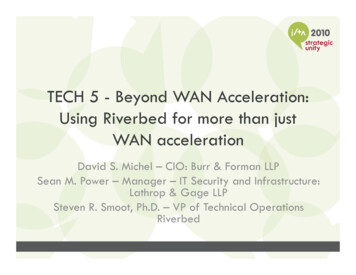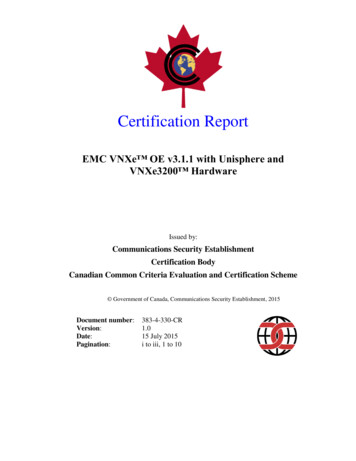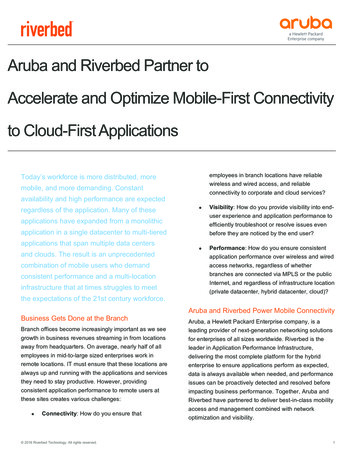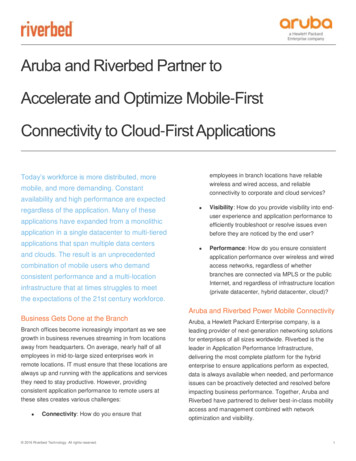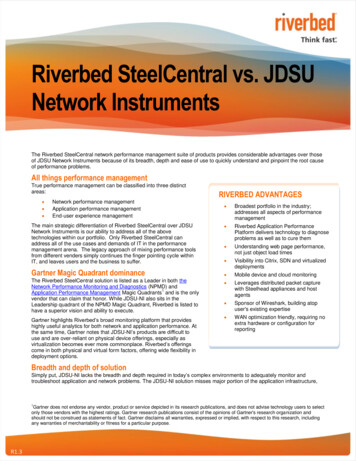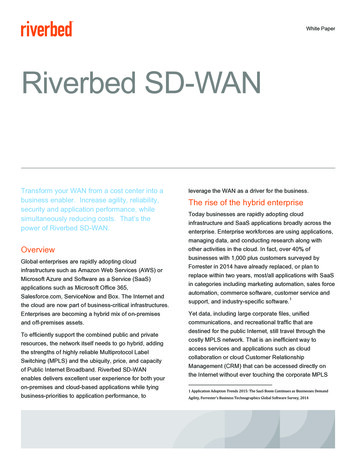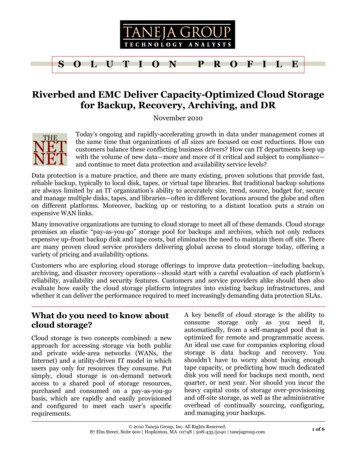
Transcription
S O L UT I O NP R O F I LERiverbed and EMC Deliver Capacity-Optimized Cloud Storagefor Backup, Recovery, Archiving, and DRNovember 2010Today’s ongoing and rapidly-accelerating growth in data under management comes atthe same time that organizations of all sizes are focused on cost reductions. How cancustomers balance these conflicting business drivers? How can IT departments keep upwith the volume of new data—more and more of it critical and subject to compliance—and continue to meet data protection and availability service levels?Data protection is a mature practice, and there are many existing, proven solutions that provide fast,reliable backup, typically to local disk, tapes, or virtual tape libraries. But traditional backup solutionsare always limited by an IT organization’s ability to accurately size, trend, source, budget for, secureand manage multiple disks, tapes, and libraries—often in different locations around the globe and oftenon different platforms. Moreover, backing up or restoring to a distant location puts a strain onexpensive WAN links.Many innovative organizations are turning to cloud storage to meet all of these demands. Cloud storagepromises an elastic “pay-as-you-go” storage pool for backups and archives, which not only reducesexpensive up-front backup disk and tape costs, but eliminates the need to maintain them off site. Thereare many proven cloud service providers delivering global access to cloud storage today, offering avariety of pricing and availability options.Customers who are exploring cloud storage offerings to improve data protection—including backup,archiving, and disaster recovery operations—should start with a careful evaluation of each platform’sreliability, availability and security features. Customers and service providers alike should then alsoevaluate how easily the cloud storage platform integrates into existing backup infrastructures, andwhether it can deliver the performance required to meet increasingly demanding data protection SLAs.What do you need to know aboutcloud storage?Cloud storage is two concepts combined: a newapproach for accessing storage via both publicand private wide-area networks (WANs, theInternet) and a utility-driven IT model in whichusers pay only for resources they consume. Putsimply, cloud storage is on-demand networkaccess to a shared pool of storage resources,purchased and consumed on a pay-as-you-gobasis, which are rapidly and easily provisionedand configured to meet each user’s specificrequirements.A key benefit of cloud storage is the ability toconsume storage only as you need it,automatically, from a self-managed pool that isoptimized for remote and programmatic access.An ideal use case for companies exploring cloudstorage is data backup and recovery. Youshouldn’t have to worry about having enoughtape capacity, or predicting how much dedicateddisk you will need for backups next month, nextquarter, or next year. Nor should you incur theheavy capital costs of storage over-provisioningand off-site storage, as well as the administrativeoverhead of continually sourcing, configuring,and managing your backups. 2010 Taneja Group, Inc. All Rights Reserved.87 Elm Street, Suite 900 Hopkinton, MA 01748 508-435-5040 tanejagroup.com1 of 6
S O L UT I O NCloud storage delivers the right amount ofstorage resources, when you need them, at amuch lower, more predictable cost.What is driving the move tocloud storage?When exploring any new approach to dataprotection, including storage in the cloud,common concerns arise: How available is the storage platform, andwill data be there when I need it? Is the security infrastructure in the cloudadvanced enough to satisfy my recoverySLAs and compliance requirements? Can I rely on consistent performance forboth backup and recovery operations? How much will I have to invest in trainingand reconfiguration of my existing backupinfrastructure?Luckily, the last several years have seen majorinvestments made in cloud technologyinnovations, and the emergence of many highlysuccessful public cloud services offerings.Cloud storage technologies have matured rapidly,driven by the needs of large-scale Internetproperties that were designed from the groundup with security, massive scalability and veryhigh availability in mind.At the same time, customer and end-userexperience and expectations have changed. Moreand more applications are built and delivered viaa network (Internet, private WAN or LAN) with abrowser-based interface. This in turn has led tomore comfort decoupling the user experiencefrom back-end services, and to the evolution ofpowerful new web-based, remote accessarchitectures and protocols.RESTful web services and SOAP are the primarymethods for data transfer and manipulation inP R O F I LEthe cloud, and enable developers to quicklydeliver rich added-value functionality to users ina familiar way.Finally, the growth in data of the last few yearshas been accompanied by an equally rapidgrowth in the number and types of mobiledevices in use—including smart phones,netbooks and tablets—that need access to remotedata from anywhere. This has further driven thedemand for innovative HTTP-based data accessand management solutions.To meet this demand, EMC and Riverbed havecombined the best of their development teamsand expertise to create a powerful, flexible cloudoptimized storage platform plus a cloudoptimized storage accelerator to enable fast,secure, and efficient interface to the platform.The Cloud Storage Platform:EMC’s AtmosEMC delivers cloud-optimized storage—readywhenever you need it, wherever you need it. EMCpioneered the cloud storage market with Atmos,which was purpose-built for cloud-scale datastorage and is based on a global network ofhighly efficient and interconnected storagedevices.The Atmos architecture is designed for massivescalability, both within and across locations, tosupport the growing cross-industry demand forelastic enterprise object storage (Fig. 1).EMC has also focused from the beginning onmanagement simplicity and comprehensivepolicy support, enabling customers to easilydefine and manage the movement of their mostcritical data, as well as to specify how and wherethat data is stored.Atmos delivers a broad range of immediatebenefits to cloud storage service providers and, inturn, to their end-user business customers: 2010 Taneja Group, Inc. All Rights Reserved.87 Elm Street, Suite 900 Hopkinton, MA 01748 508-435-5040 tanejagroup.com2 of 6
S O L UT I O NP R O F I LEATMOS REST API Easy integration, App control Highly scalable & flexible Metadata for tags and policies WAN or LAN, on premises or off Device, OS and language agnostic Custom or Packaged applicationsMultiple applications and/or tenantsREST, SOAP, NFS, CIFS access methodsGlobal scale namespace spans locationsATMOS ARCHITECTUREMulti-tenancy securely segregates data Multiple applications Multiple access methods Multiple tenants Multiple policies Multiple sitesPolicies automate data managementBuilt-in protection and efficiency servicesSITE #1SITE #2SITE #3Los AngelesNew YorkLondon SINGLE SYSTEM!Fig. 1: Key Features of EMC’s Atmos Cloud Storage Platform End-to-end automation is included: autoconfiguration, auto-management, and autohealing. Policies also control a wide range ofall-in-one data services, including versioning,compression, deduplication, and spin-down. GeoProtect includes automatic replication tomultiple geographic locations as well as“erasure coding,” which further improvesavailability and accessibility by dividingstorage objects into multiple segments andalso distributing these segments acrossgeographies.Policy-based, Automated Management:Atmos automatically distributes contentbased on business policies specified by an ITadministrator, giving the administrator fullcontrol over how and when data is replicated,and where it should reside. Flexible, Intuitive Management: Atmospresents data objects in the cloud via a single,unified namespace, which enables universalaccess regardless of location, reducesapplication development complexity, andlowers operational overhead. GUI, commandline and API management interfaces areavailable.Cloud-OptimizedDataProtection:Atmos includes a full suite of advancedcontent-protection methods, specificallydesigned for large-scale distributed objectstorage. Atmos’ GeoProtect feature gives theadministrator fine-grained controls tobalance protection levels, performance, andstorage costs for all data residing in the cloud.Secure Multi-Tenancy: Atmos wasdesigned from first principles for very highlevels of data security—both at rest and whilein transit—so that multiple applications andusers can securely share a commoninfrastructure.Every user and application space ispartitioned, creating a trusted multi-tenantplatform. This is especially important forservice providers who wish to offer secureenvironments for multiple customers, andalso benefits larger enterprises that wish tologically separate data within their ownAtmos clouds. Broad Protocol Support: Atmos is idealfor today’s distributed web applicationdevelopers, providing flexible web servicesaccess(REST/SOAP)forweb-scaleapplications and file access (CIFS, NFS, IFS)for traditional applications. 2010 Taneja Group, Inc. All Rights Reserved.87 Elm Street, Suite 900 Hopkinton, MA 01748 508-435-5040 tanejagroup.com3 of 6
S O L UT I O NThe Cloud Storage Accelerator:Riverbed’s WhitewaterCloud-optimized object storage is an idealsolution for today’s data protection challenges,but only if customers can securely and efficientlyaccess these storage resources. In our experience,any storage solution that doesn’t complementexisting data protection technologies andprocedures will complicate or replace them.Recognizing this challenge, Riverbed has appliedits expertise in WAN optimization technology tothe access, security and performance challengesunique to cloud storage.WAN optimization from Riverbed has beenbattle-tested and proven to significantly reducethe amount of data on the wire, optimize theperformance of the TCP protocol, and acceleratethe broadest number of key business applicationsof any solution of its kind.In particular, Riverbed’s solutions are especiallywell-suited to accelerating long-distance dataprotection operations, including backup andrecovery, replication, and DR.P R O F I LEBuilding on the comprehensive, multi-tieredWAN optimization features in its Steelheadproduct line, Riverbed has now developed anappliance specifically for cloud storageacceleration: Whitewater.Similar to how Steelhead overcame WANprotocol inefficiencies for enterprise WANdelivered applications, Whitewater attacks thechallenges of cost-effectively accessing, storingand protecting data in the cloud.Whitewater is essentially cloud storageacceleration in a box. Customers can easilyleverage inexpensive, pay-as-you-go cloudstorage services, like those based on Atmos, foroff-site storage of backup data, and enjoy simpleconfiguration, faster data transfers, and built-incomprehensive security features.Moreover, implementation is non-disruptive:customers can use the same data protectioninfrastructure they use today, the same protocols,and the same schedules and procedures. Theonly significant operational impact will be thetime and effort saved by no longer having tomanage or recover from off-site disk and tapes.Figure 2: Atmos/Whitewater Architecture Diagram. The Whitewater physical or virtual appliance resides in the customer’sdatacenter and is accessed in the same way as any disk backup target from existing backup applications. 2010 Taneja Group, Inc. All Rights Reserved.87 Elm Street, Suite 900 Hopkinton, MA 01748 508-435-5040 tanejagroup.com4 of 6
S O L UT I O NP R O F I LFast, Secure, and EfficientWith Whitewater, the cloud becomes a secureand reliable backup target, accessed like anyother storage target at a customer’s site. Now,however, that backup target can be sized up ordown on demand, capacity-optimized andaccelerated when Whitewater is paired with acloud storage service built on Atmos.Unlike Steelhead, Whitewater is a single-endedsolution: only one appliance is needed at thecustomer site to accelerate backups and recoveryto/from the cloud. The Whitewater appliance isavailable in both physical and virtual editions,and delivers: End-to-end security for off-site data: Allbackup data written to Whitewater is fullyencrypted while in transit via SSL v3 andwhile at rest in the cloud with 256-bit AES.Whitewater manages the encryption keys,which can be transferred to any otherphysical or virtual appliance for recovery of acustomer’s current cloud data—anywhere.Accelerated network performance forfaster recovery: Recent backup data setsare stored on Whitewater before they arereplicated to the cloud, providing reliablelocal data recovery that remains .Recovery from the cloud is faster viaWhitewater’s best-in-class deduplication andWANoptimizationfeatures,whichdramatically reduce the time to recoveranything, from a single file to a volume ormore. In addition, QoS capabilities in theappliance can throttle the bandwidthconsumed by a backup job if need be. Lower off-site storage requirements:Whitewater utilizes Riverbed’s patented datadeduplication technology to compare newbackup sets and deltas to data already writtenEto the cloud, and only writes new data, savingsignificant bandwidth to/from the cloud andrequiring less cloud storage.Deduplication is byte-level, which issignificantly more granular than block-leveland yields much higher deduplicationratios—and therefore far greater networkefficiency. Easy integration into existing backupinfrastructures: Whitewater looks like anyother local disk target to existing backupsoftware (e.g., Symantec NetBackup/BackupExec or IBM Tivoli Storage Manager) and canbe accessed via CIFS or NFS protocols.At the cloud side, Whitewater supports all theimportant cloud access APIs, includingREST, EMC Atmos, and HTTP, so there is noneed to recode existing backup software tocommunicate with the cloud.How Whitewater WorksImplementing cloud backup storageWhitewater and Atmos is simplestraightforward:withand1. Without modifying your current backupinfrastructure, add a Whitewater physical orvirtual appliance as a new backup target;2. Backups directed to Whitewater areautomatically deduplicated at the byte level,reducing data storage requirements by 10x to30x on average;3. Whitewater’s local disk retains copies ofrecent backups, providing a source for LANbased recovery of recent data;4. Deduplicated backups are written to theAtmos cloud using an object-based REST APIplus Riverbed WAN optimization technology,reducing WAN bandwidth requirements andshrinking backup and recovery times; 2010 Taneja Group, Inc. All Rights Reserved.87 Elm Street, Suite 900 Hopkinton, MA 01748 508-435-5040 tanejagroup.com5 of 6
S O L UT I O N5. Encryption keys are managed by thecustomer on the Whitewater appliance,enabling recovery from the cloud to anyWhitewater appliance, anywhere.Whitewater ships as a no-cost virtual appliancewith a raw local disk capacity of 2TB and in twoP R O F I LEphysical appliance models that scale up to 16TBof local disk.Depending on the type of data and backupfrequency, customers can expect 10-30x datareduction via deduplication, and a correspondingreduction in cloud storage requirements.Taneja Group OpinionRiverbed and EMC have each pioneered many enterprise WAN optimization and storage technologies,and both companies enjoy strong reputations as innovators. Cloud storage is poised to fundamentallychange the way businesses of all sizes think about storage capacity (utilization, trending, andpurchasing) and how to best protect critical data at the most predictable and efficient cost point. In ourview, these innovators have targeted the right customer challenge, and together can deliver a new wayof thinking about data protection.By ensuring compatibility between the Atmos cloud storage platform and the Whitewater cloud storageaccelerator, Riverbed and EMC have tapped into the most important driver of cloud computing: thedesire for clients to move away from CapEx-heavy upfront investment in IT resources, and toward aservice-based, more predictable OpEx model. And no IT capital expense is growing faster in mostorganizations than storage.Atmos by itself is highly reliable, available, secure, and globally distributed. With policy-basedautomation, Atmos greatly simplifies data management operations while giving the IT administratorcomplete control. Atmos is proven in the market, and gives cloud service providers an ideal platform tomaximize their investments in infrastructure by providing new and innovative high-performancebackup and archiving services to their customers.By adding Whitewater as the front-end access point to Atmos, the end-user benefits are multipliedfurther: existing backup processes require no modification (no “forklift” upgrades) because Whitewaterspeaks their language already. Whitewater delivers unmatched byte-level deduplication, fullencryption, and a virtual edition that allows users to restore data to nearly any server, in any location.Customers will enjoy cloud backup and replication at LAN-like performance that is as reliable andsecure as local disk or tape (if not more so)—at a lower cost. Service providers will be able to offer newstorage solutions without being limited by high conversion costs or inefficient network access. In ouropinion, the Riverbed-EMC solution goes a long way to tearing down any remaining barriers to theadoption of cloud storage.NOTICE: The information and/or product recommendations herein are based upon public information and sources and may includepersonal opinions of the Taneja Group and others, which we believe to be accurate and reliable. However, as market conditions change andare not within our control, the information and recommendations are provided without warranty of any kind. All product namesmentioned herein are the trademarks of their respective owners. The Taneja Group assumes no responsibility or liability for any damageswhatsoever (including incidental, consequential or otherwise), caused by your use of, or reliance upon, the information andrecommendations herein, nor for any inadvertent errors that may appear in this document. 2010 Taneja Group, Inc. All Rights Reserved.87 Elm Street, Suite 900 Hopkinton, MA 01748 508-435-5040 tanejagroup.com6 of 6
Riverbed and EMC Deliver Capacity-Optimized Cloud Storage for Backup, Recovery, Archiving, and DR November 2010 Today's ongoing and rapidly-accelerating growth in data under management comes at the same time that organizations of all sizes are focused on cost reductions. How can customers balance these conflicting business drivers?
